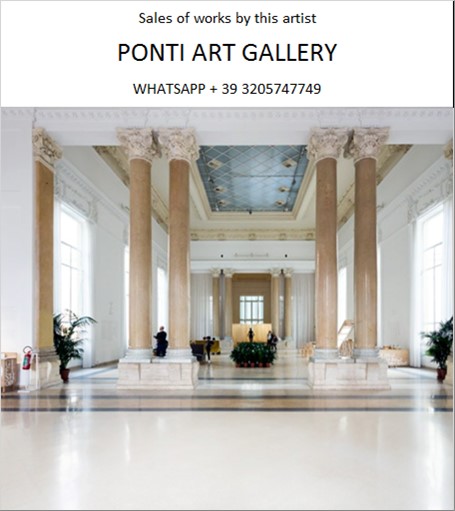Ponti Art Gallery is interested in buying and selling works
of art by this artist.

Bruno Cassinari Biography
Bruno Cassinari was an Italian painter and sculptor, born on October 29, 1912, in Piacenza, a city in the Emilia Romagna region of Italy. His artistic journey began in his hometown, where he attended the local art school, but his aspirations soon led him to Milan, a city that would become central to his development as an artist. There, he studied painting at the Brera Academy under the guidance of Aldo Carpi, a significant figure in his early artistic education.
Cassinari's work is characterized by a unique blend of cubist and expressionist elements, which he developed into a distinctive style that set him apart from his contemporaries. His early years in Milan were marked by a vibrant artistic scene, and in 1946, he played a pivotal role in founding the Fronte Nuovo delle Arti, an association aimed at revitalizing post-war Italian art. This group included other notable artists such as Renato Birolli, Renato Guttuso, Ennio Morlotti, Leoncillo Leonardi, and Alberto Viani, all of whom sought to infuse Italian art with a new sense of optimism after the devastation of World War II.
Cassinari's talent was recognized early on, and in 1949, he received an invitation from none other than Pablo Picasso to exhibit his work at the Antibes Museum of Art. This recognition by Picasso was a testament to Cassinari's growing influence and the international appeal of his art. His success continued to flourish, and in 1952, he was awarded the Grand Prize for Painting at the 26th Venice Biennale for his Cubist-inspired paintings "The Lemon" and "Still Life in Pink," further cementing his reputation as a leading figure in Italian painting.
The 1960s saw Cassinari briefly relocating to Venice, a move that allowed him to immerse himself in another of Italy's rich artistic environments. However, Milan remained his primary base, and in 1986, his contributions to Italian painting were honored with a large-scale retrospective of his work in the city. This retrospective was a celebration of his career and the impact he had on the Italian art scene.
Cassinari's personal life was closely intertwined with his artistic career. He was married to Enrica, who passed away about a year before him. The couple's relationship and shared experiences likely influenced his artistic output, as personal connections often do for artists. Bruno Cassinari died in Milan on March 26, 1992, leaving behind a legacy that had a lasting impact on Italian art.
Throughout his career, Cassinari was associated with several artistic movements and groups, including the Novecento Italiano, a movement founded in Milan in 1922 to create an art based on the rhetoric of fascism. However, Cassinari maintained a degree of independence from the group's politics, focusing instead on his personal artistic exploration. His style evolved over the years, but he remained true to his unique vision, which combined formal deformation with expressionist tendencies.
Cassinari's work was not limited to painting; he was also a skilled sculptor and illustrator. His approach to art was somewhat naive, yet it was deeply influenced by the likes of Cezanne, Matisse, and the Expressionists. His main focus was on portraiture and the exploration of historical themes, particularly the figure of the reclining odalisque, a subject that allowed him to delve into the human form and its representation in art.
In addition to his artistic pursuits, Cassinari was also an educator, sharing his knowledge and passion for art with future generations. He was appointed Professor of Figure Drawing at the Liceo artistico in Milan in 1940 and later became a Professor of Painting at the Brera Academy. His influence extended beyond his own work, as he shaped the minds and talents of students who would go on to become artists in their own right.
Cassinari's art has been featured in numerous exhibitions and is held in private and public collections worldwide. His contributions to Italian art have been recognized through various awards and accolades, and his work continues to be celebrated for its innovation, emotional depth, and the unique vision that he brought to the Italian art scene. Bruno Cassinari remains a significant figure in the history of 20th-century Italian art, and his legacy endures through the timeless quality of his work.
Bruno Cassinari Quotes and
Sales of Works
Ponti Art Gallery selects and deals with paintings by the
artist. Upon request, we provide free estimates and
evaluations, communicate prices, quotations, and current
market values.
If you are interested in BUYING or SELLING works by the
artist, contact us immediately.
If you wish to sell or receive an evaluation of the
works:
Send us a frontal photo of the painting, one of the back,
and one of the signature. Also, indicate the dimensions of
the work. Inform us about the purchase origin of the work
and any kind of available documentation (purchase
receipts, certificates of authenticity, publications). One
of our operators will respond to you on the same day. We
guarantee maximum confidentiality and extreme
professionalism.
If you wish to purchase works by the painter: Contact us
and let us know your request. We will inform you about the
available works. We also offer the possibility to
subscribe to our NEWSLETTER, through which you will be
informed at the beginning of each month about the latest
acquisitions of the art gallery.
You can send us pictures of the work:
